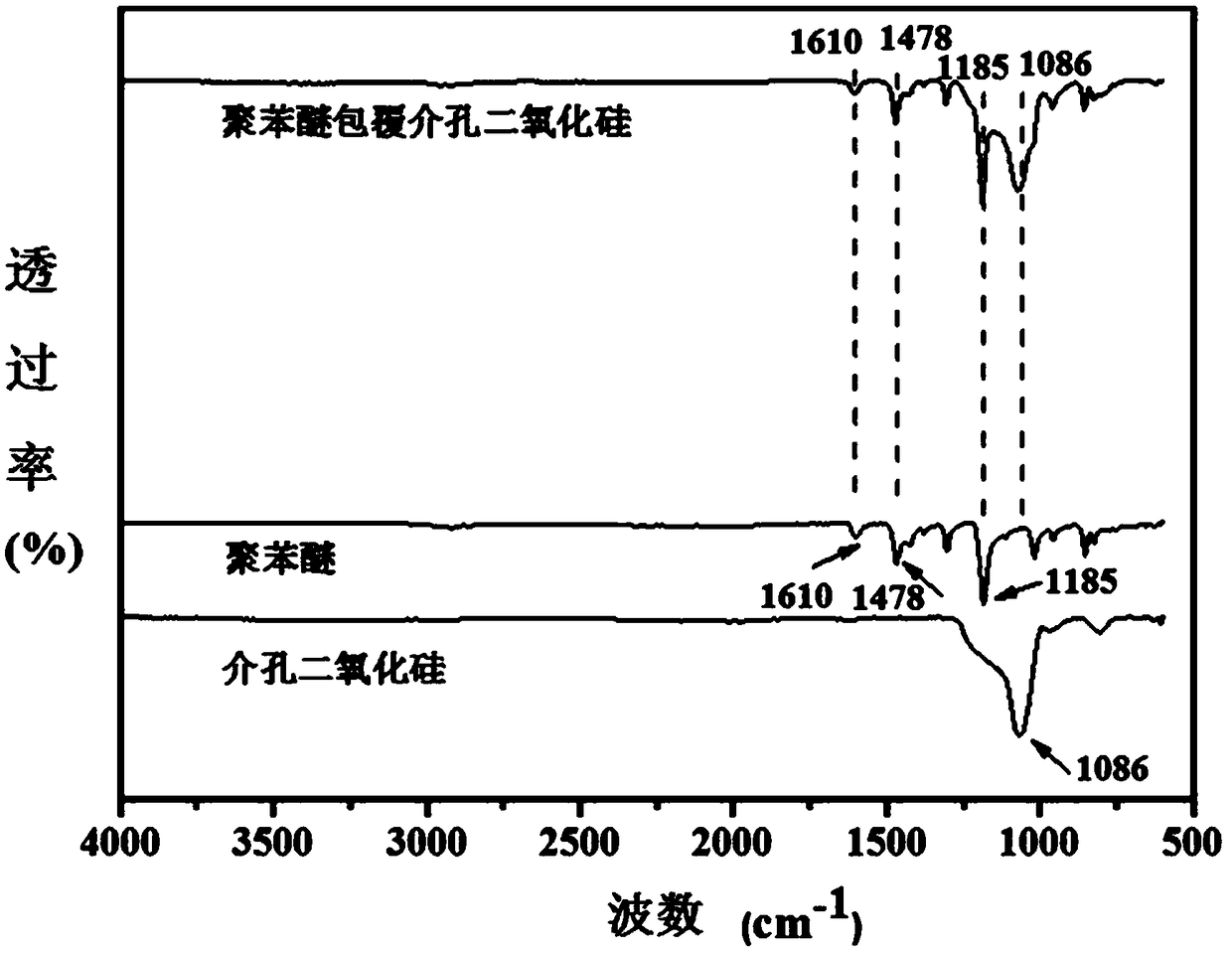Low-dielectric bismaleimide resin system
A technology of bismaleimide resin and bismaleimide, which is applied in the field of low-dielectric high-performance resin-based composite materials and low-dielectric bismaleimide resin systems, can solve the problem of thermosetting resin system dielectric Poor electrical properties, reduced resin system crosslinking density, strength, heat resistance, low moisture absorption, etc., to achieve excellent mechanical properties and thermal properties, good mechanical properties, and low dielectric properties
- Summary
- Abstract
- Description
- Claims
- Application Information
AI Technical Summary
Problems solved by technology
Method used
Image
Examples
Embodiment 1
[0029] 2g of polyphenylene ether (vinyl-terminated polyphenylene ether (PPO* MX9000-111) with a number average molecular weight of 1100) was completely dissolved in 25ml of toluene to obtain a polyphenylene ether solution, and then 0.6g of mesoporous silica was added (UC-S-1), after stirring and dispersing, add to 500ml aqueous solution of sodium lauryl sulfate surfactant with a mass concentration of 0.15% to form an oil-in-water system. Since polyphenylene ether is insoluble in water, with the gradual volatilization of the toluene solvent, the precipitated polyphenylene ether will be deposited or adsorbed on the surface of the mesoporous silica, sealing the mesopores. After stirring for 4 hours, the precipitate was washed, filtered, and dried in vacuum at 120°C for 4 hours to obtain a polyphenylene ether-filled and coated mesoporous silica material. The mass ratio of polyphenylene ether to the mesoporous silica material was 3.3: 1. figure 1 Scanning electron microscope (SEM) p...
Embodiment 2
[0037] 2g polyphenylene ether (vinyl-terminated polyphenylene ether (PPO* MX9000-111) with a number average molecular weight of 1100) was completely dissolved in 25ml of toluene to obtain a polyphenylene ether solution, and then 1.0g of mesoporous silica was added (UC-S-1), after stirring and dispersing, add it to the aqueous solution of 500ml sodium lauryl sulfate surfactant with a mass concentration of 0.2% to form an oil-in-water system. Since polyphenylene ether is insoluble in water, with the gradual volatilization of the toluene solvent, the precipitated polyphenylene ether will be deposited or adsorbed on the surface of the mesoporous silica, sealing the mesopores. After stirring for 5 hours, the precipitate is washed, filtered, and dried under vacuum at 120°C for 5 hours to obtain polyphenylene ether-filled and coated mesoporous silica material. The mass fraction ratio of polyphenylene ether to mesoporous silica material is 2 :1. Figure 4 SEM picture of mesoporous sili...
Embodiment 3
[0045] 2g of polyphenylene ether (the number average molecular weight of 2200 vinyl-terminated polyphenylene ether (Noryl* SA9000)) was completely dissolved in 30ml of toluene to obtain a polyphenylene ether solution, and then 1.4g of mesoporous silica (UC- S-3) After stirring and dispersing, it is added to the aqueous solution of 500ml potassium monododecyl phosphate surfactant with a mass concentration of 0.3% to form an oil-in-water system. Since polyphenylene ether is insoluble in water, with the gradual volatilization of the toluene solvent, the precipitated polyphenylene ether will be deposited or adsorbed on the surface of the mesoporous silica, filling or sealing the mesopores. After stirring for 6 hours, the precipitates are washed, filtered, and dried under vacuum at 120°C for 6 hours to obtain polyphenylene ether-filled and coated mesoporous silica materials. The mass fraction ratio of polyphenylene ether to mesoporous silica is 1.43. :1.
[0046] Mix 50g of bismaleim...
PUM
| Property | Measurement | Unit |
|---|---|---|
| pore size | aaaaa | aaaaa |
| particle diameter | aaaaa | aaaaa |
| dielectric loss | aaaaa | aaaaa |
Abstract
Description
Claims
Application Information
 Login to View More
Login to View More - R&D
- Intellectual Property
- Life Sciences
- Materials
- Tech Scout
- Unparalleled Data Quality
- Higher Quality Content
- 60% Fewer Hallucinations
Browse by: Latest US Patents, China's latest patents, Technical Efficacy Thesaurus, Application Domain, Technology Topic, Popular Technical Reports.
© 2025 PatSnap. All rights reserved.Legal|Privacy policy|Modern Slavery Act Transparency Statement|Sitemap|About US| Contact US: help@patsnap.com



